Home » Newsletters » 2015 News » March 2015 Newsletter

Miami Beach City Hall
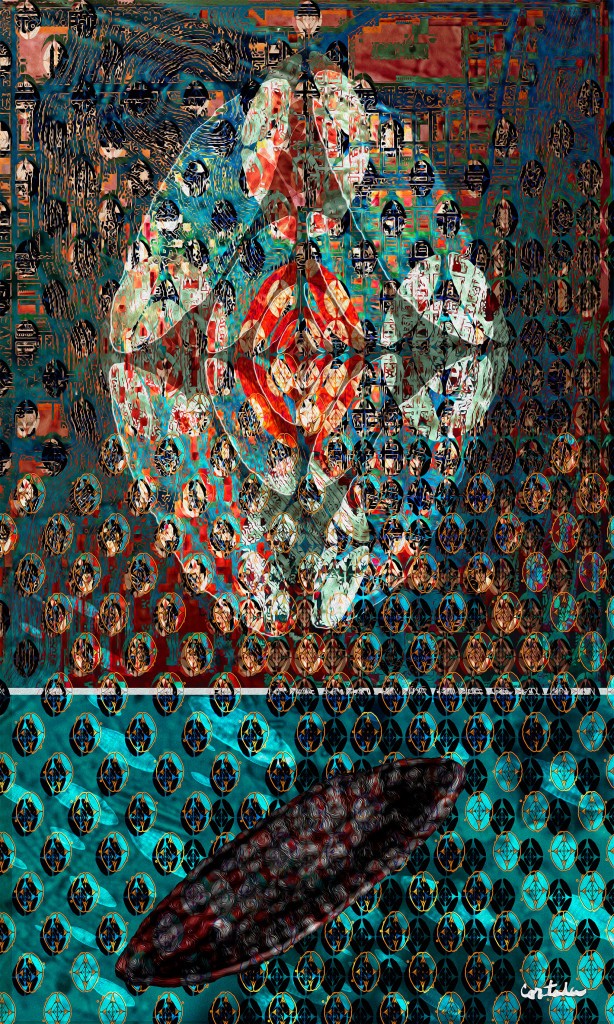
Xavier Cortada, Just Below the Surface –1915 (The Founding of Miami Beach),
60in x 36in, archival ink on aluminum, 2015. Gift of FIU College of Architecture + The Arts
and FIU School of Environment, Arts and Society to the City of Miami Beach.
Miami Beach Centennial
In honor of Miami Beach’s centennial anniversary, FIU College of Architecture + The Arts artist-in-residence Xavier Cortada will unveil a 5′ x 3′ digital painting of his art piece, “Just below the surface: 1915 (The Founding of Miami Beach),” at City Hall, fourth floor on Tuesday at 11 a.m.
Cortada was inspired by a 1915 microscopic diatom – a single-celled organism that lived in the water and harnessed the power of the sun to convert CO2 into oxygen -that FIU scientist Evelyn Gaiser was studying in her lab to help address sea level rise. Cortada’s artwork captures these diatom images of glass-encased algae that lived in Biscayne Bay 100 years ago.
In the art, there is a large diatom just below the surface. It is wrapped in red, almost resembling a hemoglobin molecule that transports oxygen to blood cells. The diatom and the whole web of life it supports above and below the waterline is our lifeline. Above the horizon, images of the diatom are arranged into a circle to symbolize the Miami Beach sun rising above the water and shinning its light on the city. Through time, season after season (represented by the sun divided in four parts), the city grows, new life. The sun is also layered over a historic city map.
“The environment is what gives life to the city,” said Cortada. “It is what we need to protect the most in its next 100 years.”
Princeton:

Princeton University
CENTER FOR MIGRATION AND DEVELOPMENT
Colloquium Series
Xavier Cortada
“Ice, Sea Stars and Flowers”
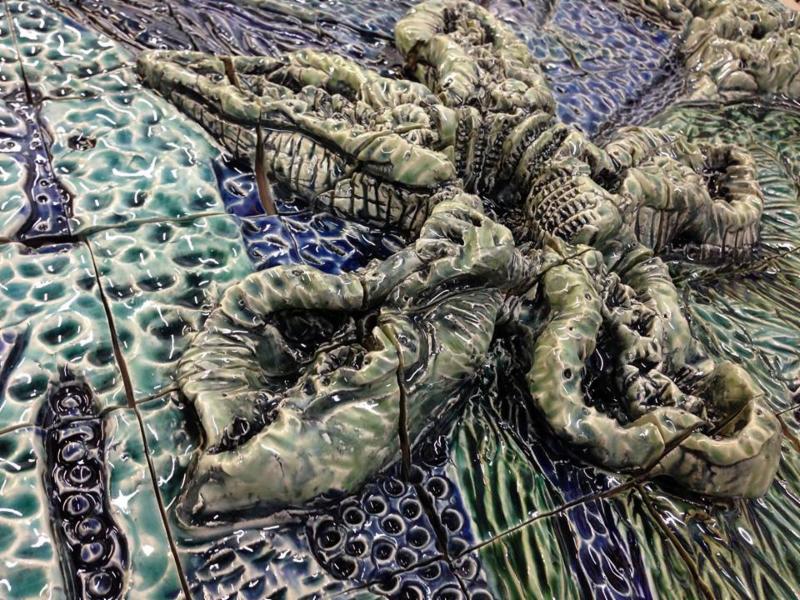
Coral Gables: University of Miami CAS Gallery
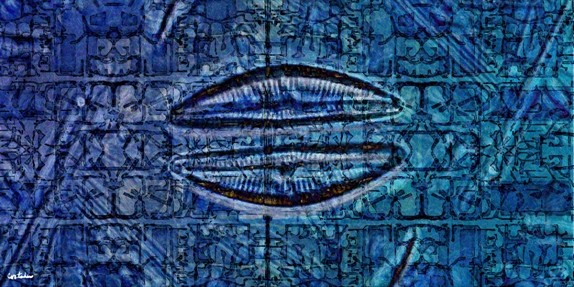
AnthropoScene: Art and Nature
in a Manufactured Era
In the art, Cortada’s diatoms hover over a layer of images (Cortada captured using Google maps) showing the artificial canals and lakes created to develop parcels of developable land where the Everglades’ River of Grass once flowed.
Key Largo: Gallery at Kona Kai
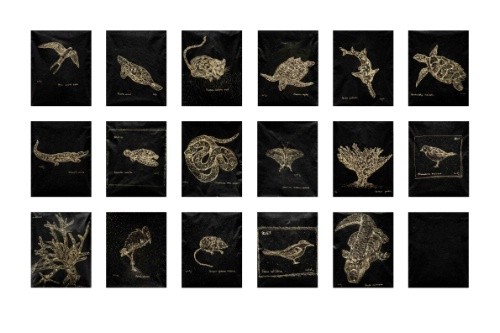
Saving the Seagrasses:
Littoral Creatures
Ontario: McMichael Canadian Art Collection

Vanishing Ice: Alpine and
Polar Landscapes in Art, 1775 – 2012
The exhibit features Cortada’s “Astrid” ice painting; read about it below:
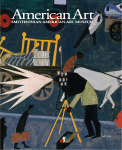
The University of Chicago Press on behalf of the
In 2007 the Miami-based artist Xavier Cortada produced Astrid, a small abstract painting consisting of liquid splotches of blue pigment in a grainy, grayish-white field on paper (fig. 1). The work recalls postwar expressionism of the New York School or later post-painterly abstraction, but such associations only scratch the surface of the picture’s meaning. The more we learn about the artist, his materials, and the context of production, the more we recognize this to be a work of our time, even as it gestures to the past and future. Cortada created Astrid at McMurdo Station, the U.S. Research Center on Ross Island, Antarctica, during a National Science Foundation Antarctic Artists and Writers Fellowship in 2006-7. The picture belongs to a series of mixed-media Ice Paintings that he produced there using ice and sediment samples from the nearby Ross Sea and Dry Valleys of West Antarctica provided by scientists studying climate change. The painting’s title, Astrid, refers somewhat counterintuitively to the King Leopold and Queen Astrid Coast, located far away along the eastern shore of Antarctica. According to the artist, he chose titles for works in this series “by randomly selecting the names of geographic features from a map of the continent that inspired their creation.” Randomness aside, Cortada has asserted unambiguously his environmentalist belief that human beings are “custodians of the planet who should learn to live in harmony with nature.”1
Currently artist-in-residence at Florida International University, Cortada exemplifies the cultural and ecological transnationalism of the twenty-first century. In addition to producing work on commission for the White House, the World Bank, and numerous public collections in Florida, he has collaborated with artists around the world, creating eco-art projects in the Netherlands, Latvia, and Hawai’i, peace murals in Cyprus and Northern Ireland, AIDS awareness murals in Geneva and South Africa, and child welfare murals in Bolivia and Panama. Cortada is an American artist but also self-consciously a citizen of the planet. He describes his most recent series, Ancestral Journeys, a collaborative project with the National Geographic scientist Spencer Wells, as “work that uses genetic data to explore how nature influenced human migration and history,” specifically regarding the various pathways that today’s residents of the Western Hemisphere took from Africa sixty thousand years ago. His point here is that “Perceived differences among people [have] often allowed for exploitation, marginalization, segregation and alienation. Inside our DNA we carry genetic markers that prove that we share the same ancestors and are one human family.”2
Returning to Astrid with Cortada‘s eco-cultural sensibility in mind, we can better appreciate how topical nuances of meaning inflect the work’s evocation of earlier expressionism. For one thing, the Antarctic materials and production site bring to mind recent reports of polar ice melt associated with global warming. Such reports have appeared since the 1970s, but in May 2014 Eric Rignot, a UC-Irvine glaciologist, announced at a NASA news conference: “Today we present observational evidence that a large sector of the West Antarctic ice sheet has gone into irreversible retreat. . . . It has passed the point of no return.” As a result, the world ocean level could rise as much as four feet within the next two centuries, forcing the displacement of millions of people from coastal areas around the globe.3
This may seem like a lot for one small painting to address, but Astrid does so at multiple registers. It creatively conjures the aerial maps and satellite images that scientists such as Rignot use to represent the increasingly unstable environment of Antarctica-a continent whose glacial disintegration has global consequences. Areas of white lightly stained with blue in Cortada‘s work metaphorically suggest continental “landmarks” like the Thwaites Ice Shelf or Pine Island Glacier Basin, which lately have begun to collapse into the ocean. Viewed in terms of materiality instead of metaphor or representation, Astrid functions as a token or specimen of a place undergoing irrevocable change wrought by human actions elsewhere-especially actions associated with Western modernity since the Industrial Revolution. As the artist informed us:
With the ice paintings, I wanted to melt the very ice that threatened to (melt and) drown my city [Miami]. The work, beautiful and serene, would be a precursor of horrors to come. . . . I melted the ice on paper to create the works, adding paint and sediment. The works were made in Antarctica, about Antarctica, using Antarctica as the medium (provided to me by the very researchers who inform us about Antarctica).4
With its expressive abstraction, Astrid recalls the heroic dynamism of American art about 1950, at the apogee of U.S. cultural modernism and military power, but its aqueous sensibility also suggests the dissolution of those human institutions amid global climate disruption-to which Americans until recently have contributed more than any other people. This interpretation takes on added significance in light of the growing scientific consensus that Earth has entered a new geological epoch, the Anthropocene, distinguished from the preceding Holocene by the fact that humans since the nineteenth century have become the primary drivers of environmental change on a planetary scale. In describing this historic development, scientists associate the post-World War II period with a “Great Acceleration” of anthropogenic transformation.5
Cortada‘s Astrid provides a fitting introduction to these issues and this series of commentaries, highlighting the significance of ecology as a key concern not only in American art today but also as a defining idea in the history of modernity writ large-an idea whose comprehension demands our acceptance of environmental change as an irrevocable fact of life.
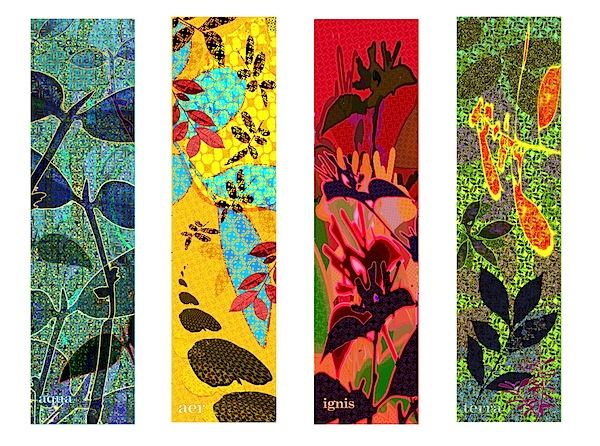
Happy Vernal Equinox!
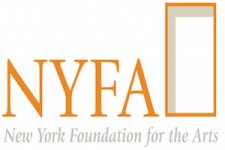
Please make your charitable donations to the New York Foundation for the Arts, fiscal sponsor of Xavier Cortada’s Participatory Eco-Art Projects, and help engage audiences in addressing global climate change concerns.